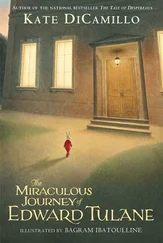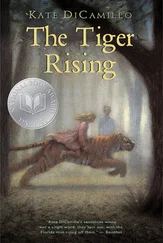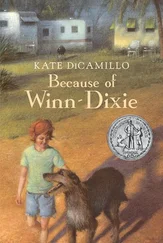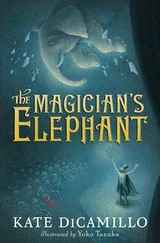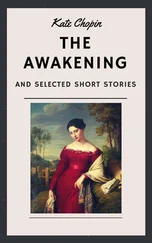The rat sniffed. “Don’t torment me,” he said.
“I promise you,” said the princess, “that if you lead us out of here, I will get Cook to make you some soup. And you can eat it in the banquet hall.”
“Speaking of eating,” shouted one of the rats, “give us the mousie!”
“Yeah,” shouted another, “hand over the mouse!”
“Who would want him now?” said Botticelli. “The flavor of him will be ruined. All that forgiveness and goodness. Blech. I, for one, am leaving.”
“Soup in the banquet hall?” Roscuro asked the princess.
“Yes,” said the Pea.
“Really?”
“Truly. I promise.”
“Gor!” shouted Mig. “Soup is illegal.”
“But soup is good,” said Despereaux.
“Yes,” said the Pea. “Isn’t it?”
The princess bent down before the mouse. “You are my knight,” she said to him, “with a shining needle. And I am so glad that you found me. Let’s go upstairs. Let’s eat some soup.”
And, reader, they did.

BUT THE QUESTION you want answered, I know, is did they live happily ever after?
Yes . . . and no.
What of Roscuro? Did he live happily ever after? Well . . . the Princess Pea gave him free access to the upstairs of the castle. And he was allowed to go back and forth from the darkness of the dungeon to the light of the upstairs. But, alas, he never really belonged in either place, the sad fate, I am afraid, of those whose hearts break and then mend in crooked ways. But the rat, in seeking forgiveness, did manage to shed some small light, some happiness into another life.
How?
Roscuro, reader, told the princess about the prisoner who had once owned a red tablecloth, and the princess saw to it that the prisoner was released. And Roscuro led the man up out of the dungeon and to his daughter, Miggery Sow. Mig, as you might have guessed, did not get to be a princess. But her father, to atone for what he had done, treated her like one for the rest of his days.
And what of Despereaux? Did he live happily ever after? Well, he did not marry the princess, if that is what you mean by happily ever after. Even in a world as strange as this one, a mouse and a princess cannot marry.
But, reader, they can be friends.
And they were. Together, they had many adventures. Those adventures, however, are another story, and this story, I’m afraid, must now draw to a close.
But before you leave, reader, imagine this: Imagine an adoring king and a glowing princess, a serving girl with a crown on her head and a rat with a spoon on his, all gathered around a table in a banquet hall. In the middle of the table, there is a great kettle of soup. Sitting in the place of honor, right next to the princess, is a very small mouse with big ears.
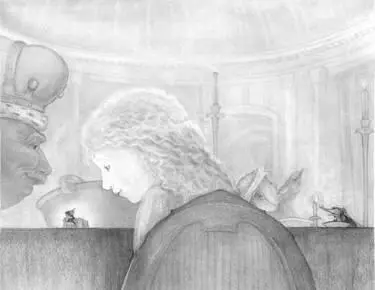
And peeking out from behind a dusty velvet curtain, looking in amazement at the scene before them, are four other mice.

“ Mon Dieu, look, look,” says Antoinette. “He lives. He lives! And he seems such the happy mouse.”
“Forgiven,” whispers Lester.
“Cripes,” says Furlough, “unbelievable.”
“Just so,” says the threadmaster Hovis, smiling, “just so.”
And, reader, it is just so.
Isn’t it?
THE END

Do you remember when Despereaux was in the dungeon, cupped in Gregory the jailer’s hand, whispering a story in the old man’s ear?
I would like it very much if you thought of me as a mouse telling you a story, this story, with the whole of my heart, whispering it in your ear in order to save myself from the darkness, and to save you from the darkness, too.
“Stories are light,” Gregory the jailer told Despereaux.
Reader, I hope you have found some light here.
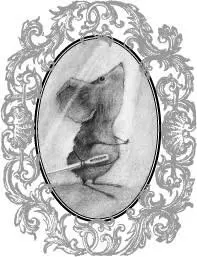
I am grateful to the following individuals for their
unflagging love, patience, and support during the
telling of the mouse’s tale: Karla Rydrych,
Jane St. Anthony, Cindy Rogers, Jane Resh Thomas,
Jason William Walton, Alison McGhee,
Holly McGhee, Lisa Beck, and Tracey Bailey.
Despereaux and I are also deeply indebted to
Kara LaReau — editor, visionary, friend.
This book was written with the help of a generous grant
from the McKnight Foundation.
Kate DiCamillo
is the author of Because of Winn-Dixie, which received a Newbery Honor; The Tiger Rising, which was a National Book Award Finalist; The Miraculous Journey of Edward Tulane, which won a Boston Globe–Horn Book Award; the best-selling Mercy Watson series; and The Magician’s Elephant. About The Tale of Despereaux, she says, “My best friend’s son asked me if I would write a story for him. ‘It’s about an unlikely hero,’ he said, ‘one with exceptionally large ears.’ ‘What happens to this hero?’ I asked. ‘I don’t know,’ he said. ‘That’s why I want you to write the story, so we can find out.’ Well, Luke Bailey, here’s the tale of your exceptionally large-eared, extremely unlikely hero. Thank you for waiting so patiently.” Kate DiCamillo lives in Minneapolis.
Timothy Basil Ering
is the author and illustrator of The Story of Frog Belly Rat Bone and Necks Out for Adventure!, as well as the illustrator of Mr. and Mrs. God in the Creation Kitchen by Nancy Wood, and Finn Throws a Fit! by David Elliot. His artwork has also appeared in magazines, theater sets, private murals, and fine art galleries. He says, “My mother may have been a mouse in her past life, as I watched her save and help so many mice in our house growing up. The illustrations I’ve done of Despereaux Tilling are, in a way, my tribute to her.”
Also by Kate DiCamillo:
Because of Winn-Dixie
The Magician’s Elephant
The Miraculous Journey of Edward Tulane
The Tiger Rising
Mercy Watson to the Rescue
Mercy Watson Goes for a Ride
Mercy Watson Fights Crime
Mercy Watson: Princess in Disguise
Mercy Watson Thinks Like a Pig
Mercy Watson:
Something Wonky This Way Comes
Great Joy









